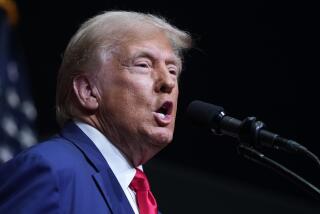Obama pumps up his stimulus plan
- Share via
WASHINGTON — President-elect Barack Obama signaled Saturday that he would quickly seek a sweeping economic recovery plan likely to exceed the $175-billion price tag of the plan he unveiled during the campaign.
A “crisis of historic proportions” is gripping the nation, Obama said, and it calls for “a plan big enough to meet the challenges we face.”
Obama has asked his economic team to craft a plan to create 2.5 million jobs over the next two years, including some in the field of alternative energy. His original plan was for one year.
The president-elect wants quick congressional approval so that he can sign legislation soon after taking office.
“These aren’t just steps to pull ourselves out of this immediate crisis,” Obama said in the weekly Democratic radio address. “These are the long-term investments in our economic future that have been ignored for far too long.”
Economic news has been worsening over the last several weeks, with financial markets in turmoil and new housing starts sinking to its lowest level in nearly 50 years. In the radio address, the president-elect mentioned a risk of a deflationary spiral and its potential to increase the nation’s debt.
Just over a month ago, Obama unveiled a proposal to help employers, automakers, homeowners and state and local government weather the economic storm. Advisors said it would cost $175 billion.
At a campaign event in Toledo, Ohio, Obama proposed a $3,000 tax credit for employers for each new person they hire. He said he would eliminate income taxes on unemployment benefits, double the government’s loan guarantee for automakers, and allow people to borrow from retirement savings without a tax penalty regardless of age.
But on Saturday, Obama said he believed the economy had deteriorated to a point of crisis, and introduced ideas he hadn’t mentioned before.
Aides to the president-elect acknowledge that Obama is widening the scope of his plan, and that its cost probably will rise.
One new detail is the 2.5 million jobs that he wants to create by 2011. He also speaks now of making it a two-year plan.
“It’s consistent with what he said before because of the prolonged deterioration in the economy,” said an Obama aide.
Another addition is investment in green technology. Obama has long talked about creating 5 million jobs by putting $150 billion into alternative energy, but not as part of his rescue plan.
On Saturday, though, he listed green jobs prominently among the investments he thinks the government should make in a stimulus plan.
“We’ll put people back to work rebuilding our crumbling roads and bridges, modernizing schools that are failing our children, and building wind farms and solar panels; fuel-efficient cars and the alternative energy technologies that can free us from our dependence on foreign oil and keep our economy competitive in the years ahead,” he said.
Obama is expected to officially announce key members of his economic team in the coming days, possibly as early as Monday, and ask them to start drafting the stimulus package.
Obama has selected Timothy F. Geithner, president of the Federal Reserve Bank of New York, as his nominee for Treasury secretary.
He has settled on New Mexico Gov. Bill Richardson as his Commerce secretary, and Congressional Budget Office chief Peter R. Orszag is his likely choice for White House budget director.
After delivering the radio address, Obama officially named a key three-member team to run his White House communications operation. Robert Gibbs, a close advisor, will serve as press secretary, and Ellen Moran, executive director of EMILY’s List, will leave her post to become communications director. Dan Pfeiffer, a key aide in the Obama campaign, will be deputy director of communications.
On Saturday, however, communication came only from the president-elect himself.
“There are no quick or easy fixes to this crisis, which has been many years in the making, and it’s likely to get worse before it gets better,” he said.
“But Jan. 20 is our chance to begin anew with a new direction, new ideas, and new reforms that will create jobs and fuel long-term economic growth.”
--
More to Read
Get the L.A. Times Politics newsletter
Deeply reported insights into legislation, politics and policy from Sacramento, Washington and beyond. In your inbox twice per week.
You may occasionally receive promotional content from the Los Angeles Times.











